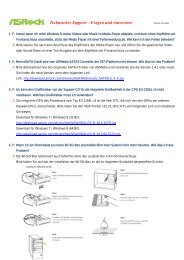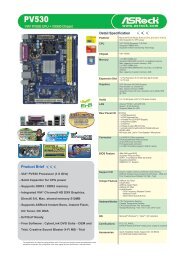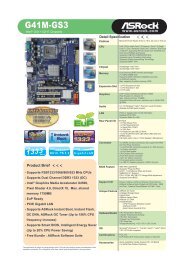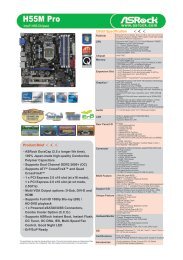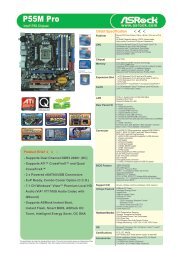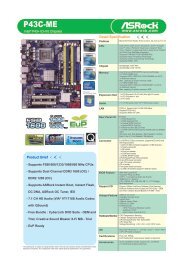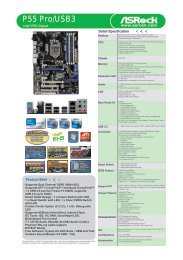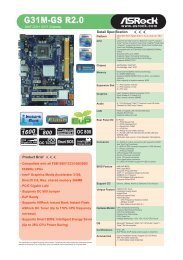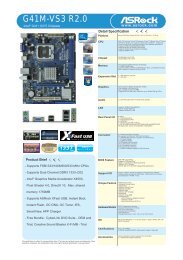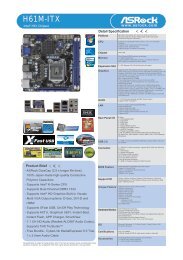Nokia & NFC AsUs Zenbook UX21 Teardown - ASRock
Nokia & NFC AsUs Zenbook UX21 Teardown - ASRock
Nokia & NFC AsUs Zenbook UX21 Teardown - ASRock
You also want an ePaper? Increase the reach of your titles
YUMPU automatically turns print PDFs into web optimized ePapers that Google loves.
Tried & tested<br />
Z68 Motherboards Under `10,000 `10,000 to `14,000<br />
brand biostar Asrock Gigabyte <strong>AsUs</strong> intel ZoTAC <strong>AsUs</strong> <strong>AsUs</strong> <strong>AsUs</strong><br />
Model No. TZ68K+<br />
90 Digit | November 2011 | www.thinkdigit.com<br />
Z68<br />
extreme3<br />
Gen3<br />
Z68Ap-d3 p8Z68<br />
Mpro<br />
dZ68d8<br />
Z68 iTX<br />
A-e<br />
p8Z68-V<br />
Le<br />
p8Z68-V<br />
price (in `) 7,990 8,800 9,880 9,901 10,000 10,600 10,994 13,041 13,110<br />
Features and specs (out of 70) 24.57 33.32 18.62 25.62 16.87 18.48 26.04 30.24 34.16<br />
board Layout (out of 10) 6.5 7.4 7.3 6.6 6 6 6.6 7.6 7.3<br />
build Quality (out of 15) 11.1 12.825 10.95 10.95 5.25 9.9 11.25 12.825 13.65<br />
package bundle (out of 5) 1.2 1 1.2 1.2 0.6 1.2 1.2 1.6 1.3<br />
overall (out of 100) 43.37 54.545 38.07 44.37 28.72 35.58 45.09 52.265 56.41<br />
specifications<br />
Max. Memory Supported (GB) / No of DIMMs 4 / 32 4 / 32 4 / 32 4 / 32 4 / 32 2 / 16 4 / 32 4 / 32 4 / 32<br />
No. of SATA 2 / SATA 3 / eSATA Ports 4/2/0 4/2/0 4/2/0 4/2/1 2/2/1 2/2/0 4/2/0 4/2/0 4/2/0<br />
No. of PCI Express x16 Graphics Slots 2 2 1 1 1 1 2 3 2<br />
Multi GPU (SLI/CrossFire) Support Y/Y Y/Y N/Y Y/Y N/N N/N Y/Y Y/Y Y/Y<br />
Optical S/PDIF Port / LAN Port N/1 Y/1 N/1 Y/1 N/1 Y/2 Y/1 Y/1 Y/1<br />
Integrated Wi-Fi (Y/N) N N N N N Y N N N<br />
No. of Ports: USB 2.0/USB 3.0 2/2 4/2 4/2 4/2 6/2 4/2 4/2 6/2 8/2<br />
No. of Ports: FireWire / eSATA 0/0 0/1 0/0 0/1 1/1 0/0 0/0 0/1 0/2<br />
Maximus<br />
iV GeNe Z<br />
Display Ports DVI / VGA / HDMI / Display Port Y/Y/Y/N Y/Y/Y/N N/N/Y/N Y/Y/Y/Y Y/N/Y/Y N/N/Y/N Y/Y/Y/N Y/Y/Y/N N/N/Y/N<br />
Power and Reset Buttons (Y/N) Y Y N N N Y N Y Y<br />
UEFI BIOS / Lucid Virtu (Y/N) Y/Y Y/Y N/Y Y/Y N/Y N/N Y/Y Y/Y Y/Y<br />
Headers: USB 2.0 / USB 3.0 3/0 4/0 3/0 5/0 4/0 2/1 4/1 3/1 2/1<br />
POST debug LED / Button for overclocking N/N Y/N N/N N/N N/N Y/N N/N N/N Y/Y<br />
Total Fan Connectors 3 6 4 3 3 2 4 6 5<br />
Form Factor ATX ATX ATX MicroATX ATX Mini ITX ATX ATX MicroATX<br />
board Layout (so 10)<br />
Region around CPU / SATA Port Location 6.5/5 7/7 6.5/7 7/5 6.5/5 6/5 7/5 7/7.5 6.5/7<br />
Placement of Memory Modules 8 8 8 8 6 7 8 8 8<br />
Graphics Card Slot and PCI Slots 8 8 8 8 7 7 8 8 8<br />
build Quality<br />
All Solid State Caps (Y/N) Y Y Y Y N Y Y Y Y<br />
Button Build / Feedback 4/8 7/8 NA NA NA 4/6 NA 7/8 8/8<br />
VRM/Southbridge Heatsink Quality 4/5 7/7 5.5/6 5.5/6 0/5 5.5/5 5.5/7 7/7 8.5/8<br />
package bundle<br />
No of SATA Cables 4 2 4 4 2 4 4 4 3<br />
USB 3 Bracket 0 0 0 0 0 1 0 0 N<br />
CrossFire / SLI Bridge 0 1 0 0 0 0 0 1 1<br />
performance (only for reference)<br />
NoVeMber 2011 NoVeMber 2011<br />
Cinebench R11.5 (OpenGL /CPU (all cores)) 51.74/6.66 51.85/6.68 52.42/6.79 51.19/6.83 55.91/6.98 49.75/6.5 51.42/6.87 51.67/6.76 52.04/6.83<br />
3D Mark Overall 4150 4109 4154 4174 4178 4146 4182 4180 4179<br />
WinRAR 4.0 (Multi-threaded) 3503 3509 3505 3516 3687 3491 3529 3535 3515<br />
100 MB file Video Encoding (VOB-DivX 7) (sec) 20.28 19.35 20.79 19.42 19.39 20.52 19.52 19.6 19.51<br />
File Transfer (Sequential /Assorted) (MB/s) 45.7/48.5 41.2/47.2 47.5/48.5 41.2/41.2 46.8/47.5 44.8/49.1 46.2/46.2 46.38/47.1 47.3/49.2<br />
USB 3.0 Sequential Write/Read (MB/s) 66.1/84.8 64.8/88.1 66.7/88.3 65.6/86.5 65.6/83.5 66.5/85.4 65.4/86.6 67.1/85.5 65.1/85.5<br />
USB 3.0 Assorted Write/Read (MB/s) 44.7/70.2 44.8/73.7 47.4/71.4 44.4/72.2 44.6/67.5 46.9/72.7 44.4/77.7 44.8/71.8 47.6/71.6<br />
Game<br />
Resident Evil 5 (1680x1050, med) 178.2 176.2 180.2 180.2 190.8 175.4 181.2 181.9 180.2<br />
STALKER: COP (1680x1050, med) 164.7 164.9 165.6 163.1 164.2 163.2 163.7 164.8 165<br />
On-board RoG features are<br />
also quite exhaustive and give you<br />
many ways to overclock or tweak<br />
your way through. RoG Connect<br />
allows you to connect your motherboard<br />
to a notebook and tune it<br />
on the fly. With iDirect, you can<br />
<strong>Nokia</strong> & <strong>NFC</strong><br />
<strong>Nokia</strong> launches <strong>NFC</strong> Hub to help in business<br />
development growth. http://bit.ly/oQ0lkx<br />
do the tweaking using an iPad or<br />
even an iPhone, a decent feature<br />
to show off to your pals. A BIOS<br />
switch allows you to maintain a<br />
copy of your stable BIOS while<br />
you tinker with the other BIOS.<br />
The Z68X-UD7-B3 is Giga-<br />
byte’s flagship Z68 board and<br />
comes with the traditional bells<br />
and whistles of all UD7 boards.<br />
A black-coloured PCB densely<br />
packed with ICs provides<br />
a perfect background to the<br />
grey/golden heatsinks. All<br />
<strong>AsUs</strong> <strong>Zenbook</strong> <strong>UX21</strong> <strong>Teardown</strong><br />
Asus’ latest ultra-slim laptop, the 11-inch <strong>Zenbook</strong><br />
was taken apart to pieces. http://bit.ly/ob2c68<br />
DIGIT<br />
the heatsinks are connected<br />
via a heat pipe which assists<br />
in heat dissipation. Compared<br />
to G1 Sniper2, this<br />
board has a good assortment<br />
of back I/O panel ports. A<br />
dedicated Start button and POST
steve Jobs was opposed to apps<br />
Excerpts from Jobs’ authorized biography reveals the Apple<br />
visionary was initially opposed to all things apps.<br />
`14,000 to `20,000 `20,000 and up<br />
Msi <strong>AsUs</strong> ZoTAC Msi Gigabyte <strong>AsUs</strong> Msi Asrock Gigabyte <strong>AsUs</strong> Gigabyte<br />
Z68MAed55<br />
NoVeMber 2011 NoVeMber 2011<br />
NoVeMber 2011<br />
p8Z68-V<br />
pro<br />
Z68 iTX b-e Z68A-Gd65<br />
b3<br />
Z68Xp-<br />
Ud3-issd<br />
p8Z68<br />
deluxe<br />
Z68A-Gd80<br />
Z68<br />
extreme7<br />
Gen 3<br />
Z68X Ud7<br />
b3<br />
Maximus iV<br />
extreme Z<br />
13,500 14,248 14,400 14,980 16,250 17,997 18,900 18,999 23,920 26,220 34,500<br />
28.42 30.38 16.45 29.33 25.13 32.69 31.43 37.8 26.11 37.03 22.61<br />
6.8 7.2 6 7.15 7.3 7.5 6.9 7.2 7.35 7.6 7.5<br />
12.75 12.825 9.975 11.55 11.7 12.825 13.05 13.425 13.2 13.65 12.6<br />
0.6 1.6 1.2 1.6 1.6 1.6 1.6 1.75 2 2.4 1.6<br />
48.57 52.005 33.625 49.63 45.73 54.615 52.98 60.175 48.66 60.68 44.31<br />
4 / 32 4 / 32 2 / 16 4 / 32 4 / 32 4 / 32 4 / 32 4 / 32 4 / 32 4 / 32 4 / 32<br />
4/2/0 4/2/2 2/2/0 4/4/0 4/2/0 4/2/2 4/3/0 4/6/0 4/2/2 4/2/2 2/2/2<br />
2 3 0 2 2 3 3 5 4 4 2<br />
N/Y Y/Y N/N Y/Y Y/Y Y/Y Y/Y Y/Y Y/Y Y/Y Y/Y<br />
Y/1 Y/1 Y/1 Y/1 Y/1 Y/2 Y/2 Y/2 Y/2 Y/2 Y/1<br />
N N Y N N N N N N N N<br />
4/2 6/2 2/2 4/2 8/2 8/2 4/2 2/4 2/6 1/8 7/2<br />
1/0 0/1 0/1 0/0 1/0 1/2 1/1 1/1 2/2 0/2 0/1<br />
G1 sniper 2<br />
Y/Y/Y/N Y/Y/Y/N Y/N/Y/Y Y/Y/Y/N N/N/Y/N N/N/N/N Y/N/Y/N Y/Y/Y/Y N/N/N/N N/N/N/N N/N/Y/N<br />
Y Y N N N Y Y Y Y Y N<br />
Y/Y Y/Y N/Y Y/Y N/Y Y/Y Y/Y Y/Y N/N Y/Y N/Y<br />
4/0 3/1 1/1 3/1 3/1 2/1 3/1 4/1 2/2 4/1 3/1<br />
N/Y N/N N/N N/Y N/N Y/N N/Y Y/N Y/N Y/Y N/Y<br />
4 6 2 5 4 5 5 6 6 8 5<br />
MicroATX ATX Mini ITX ATX ATX ATX ATX ATX ATX eATX ATX<br />
6.5/7 6/7 6/5 6.5/7 6.5/7 6.5/7.5 6.5/6 6.5/7.5 7.5/7 8/7 7.5/7<br />
6 8 7 8 8 8 8 8 8 8 8<br />
7 8 7 7.5 8 8 8 7 7.5 8 8<br />
Y Y Y Y Y Y Y Y Y Y Y<br />
8/8 7/8 5/6 NA NA 7/8 8/8 7/8 8/8 8/8 NA<br />
6.5/7 7/7 5.5/5 6.5/7 6.5/7.5 7/7 7.5/7 8.5/7.5 8/7 8.5/8 9/8<br />
2 4 4 4 4 4 4 6 4 4 4<br />
0 1 1 1 N 1 1 1 1 0 1<br />
0 1 0 1 1 1 1 1 2 3 1<br />
50.45/6.61 52.68/6.86 25.1/6.65 51.21/6.62 55.47/6.86 53.23/6.86 51.29/6.64 51.1/6.68 50.78/6.59 52.68/6.88 51.49/6.62<br />
4174 4102 1141 4159 4134 4177 4145 4144 4134 4185 4145<br />
3503 3370 3314 3505 3535 3529 3493 3491 3490 3544 3484<br />
20.42 20.23 20.76 20.42 19.97 19.34 20.34 20.41 20.51 20.07 20.86<br />
46.9/48.7 46.1/46.4 45.1/43.5 46.7/45.4 46.7/46.5 47.2/46.3 47.5/44.4 48.54/44.3 47.2/45.3 45.8/46.2 44.8/45.2<br />
68.5/84.5 67.1/86.3 61.1/81.5 67.7/85.2 63.1/82.1 65.4/86.3 68.6/83.4 67.5/82.2 66.0/80.1 65.8/86.1 67.0/81.1<br />
44.7/72.3 44.3/71.9 25.8/68.4 45.6/71.3 44.3/67.4 44.4/72.7 44.5/72.2 41.4/70.2 45.2/72.16 45.1/73.1 45.2/68.7<br />
178.4 178.2 70.7 175.8 182.4 181.1 176.5 178.4 174.4 179.1 177.9<br />
164.2 163.4 44.8 162.5 163.2 165.2 163.3 164.2 163.3 165.2 164.1<br />
debug LED are helpful additions<br />
and so is the Gigabyte DualBIOS,<br />
which lets you keep a backup<br />
of the stable BIOS in one<br />
chip. Three-way SLI at x16/<br />
x8/x8 is possible due to the<br />
NF200 chip.<br />
Another interesting feature<br />
is that you can use the USB 3.0<br />
ports as charging points for USB<br />
peripheral devices even when<br />
your system is off or in standby.<br />
The BIOS is the only<br />
sore point about this board<br />
Five pros of Google+<br />
Google+ has had its detractors but they’re wrong.<br />
Google+ is awesome. http://gizmo.do/mQ5M6j<br />
DIGIT<br />
specially when compared<br />
with the beautiful BIOS on the<br />
ASUS board. Absence of Lucid<br />
Virtu support on the board<br />
means that you won’t be able to<br />
use integrated graphics for<br />
tasks such as transcoding, but<br />
then we doubt anyone would be<br />
using integrated graphics in the<br />
first place assuming you house<br />
graphics on this board.<br />
In terms of future-proofing,<br />
all the boards have BIOSes to<br />
make them compatible with the<br />
Digit | November 2011 | www.thinkdigit.com 91
playstation 3d display coming<br />
The $499 24-inch display will begin shipping to stores and<br />
to pre-orders on November 13<br />
<strong>AsUs</strong> Msi Gigabyte Asrock Asrock<br />
F1A75-M<br />
Le<br />
A75MA-G55 A75-d3h A75 extreme6 A75 pro4-M<br />
6,158 6,865 7,020 7,500 5,950<br />
25.13 25.62 32.2 40.04 28<br />
5.9 6.45 6.9 7.6 6.05<br />
7.6 12.4 7.9 15.1 11.2<br />
38.63 44.47 47 62.74 45.25<br />
32 / 2 64 / 4 64 / 4 64 / 4 64 / 4<br />
6 6 5 8 5<br />
2 2 2 3 2<br />
N / 1 N / 1 Y / 1 Y / 1 Y / 1<br />
N N N N N<br />
4/2/0/0 4/2/0/0 2/4/0/1 2/4/1/1 2/4/0/1<br />
Y/Y/N/N Y/Y/Y/N Y/Y/Y/N Y/Y/Y/N Y/Y/Y/N<br />
N N N Y N<br />
1 / 3 1 / 2 1 / 4 1 / 3 0 / 2<br />
N N N Y N<br />
2 3 3 6 4<br />
Micro ATX Micro ATX ATX ATX Micro ATX<br />
5 6 5 6 6.5<br />
5 6 7 8 5<br />
8 7 8 8 7<br />
8 8 8 8 8<br />
Y Y Y Y Y<br />
0 0 0 7 0<br />
0 0 0 8 0<br />
0 7.5 0 7 5.5<br />
6 6.5 6.5 6.5 6.5<br />
26.14 26.44 26.72 26.56 25.97<br />
3.45 3.45 3.43 3.45 3.45<br />
1026 1033 1033 1007 1008<br />
1771 1834 1790 1834 1834<br />
41.03 40.23 39.64 39.58 40.12<br />
45.16/44.4 46.13/44.19 47.04/46.4 45.33/45.2 45.1/45.0<br />
65.04/77.2 65.37/77.8 65.24/78.7 64.4/83.3 46.3/65.2<br />
41.45/62.1 43.68/63.43 44.1/63.44 47.53/65.4 46.3/65.2<br />
Wi-Fi adapter and an onboard<br />
graphics card. Its priced higher<br />
considering it houses SO DIMM<br />
slots, which has costlier laptop<br />
RAM modules.<br />
Gigabyte Z68XP-UD3-iSSD,<br />
is the only motherboard with an<br />
on-board SLC SSD drive connected<br />
to an mSATA port just<br />
NoVeMber 2011<br />
43.1 43.5 44.5 42.8 42.6<br />
26.2 26.4 26.5 25.9 25.8<br />
below the CPU socket. The Intel<br />
20 GB SSD is ideal for users<br />
who’ll be using the Intel Rapid<br />
Storage Technology. You can use<br />
it in the Enhanced Mode which<br />
writes data to both SSD and HDD<br />
ie. mirroring and the maximised<br />
mode, which only writes to the<br />
cache memory (SSD).<br />
Vengeance is sweet<br />
Corsair announced the launch of its<br />
“rigorously-screened“, 8 GB RAM modules<br />
ASUS Maximus IV Extreme-Z<br />
Motherboards Test<br />
NoVeMber 2011<br />
Apart from the SSD, the board have the Z68A-GD80 (B3) and<br />
is quite similar to the Z68AP-D3. Z68A-GD65 (B3). The GD80 is<br />
The build quality of the board is the higher end board of the two,<br />
quite good with sturdy heatsinks. sporting dual LAN ports, three<br />
The PCIe slots can be used for SLI PCIe x16 slots, an eSATA port on<br />
as well as CrossFire, but one of the back IO panel, better quality<br />
them runs at x8 speed.<br />
heat sinks and an extra SATA<br />
ASUS has the higher-end 6 Gbps port. Build quality of<br />
P8Z68-V Pro and P8Z68 Deluxe both the boards is superb with<br />
(the highest-end board outside military class components. The<br />
the RoG series of boards) in this standard MSI components such<br />
segment. A major difference as Super Ferrite Chokes (SFC),<br />
between the two is the absence DrMOS (Driver MOSFETs) and<br />
of display ports and presence solid state caps are all present.<br />
of an extra LAN port, an extra Both boards support SLI and<br />
eSATA port, a FireWire port CrossFireX. The OC Genie button<br />
and a coaxial S/PDIF port on the for overclocking-on-the-fly and<br />
Deluxe. Both the boards support the voltage probe points are inter-<br />
dual intelligent processors such esting additions for enthusiasts.<br />
as EPU (Energy processing Unit) MSI also has the UEFI BIOS<br />
and TPU (Turbo V Processing which will take some time getting<br />
Unit). There are dedicated used to if you’re new to such kind<br />
switches to activate the EPU of BIOSes. MSI Control centre<br />
and TPU processors. While the is the utility that allows you to<br />
EPU is meant for power saving overclock your system, run it at<br />
functions, we’re more interested lower power settings with the<br />
in the TPU, as that allows you Green Power tab<br />
to automatically overclock your and monitor CPU<br />
system by hitting<br />
Start on the Auto-<br />
Tune function of the<br />
Turbo V EVO utility.<br />
It’s a boon to amateur<br />
overclockers<br />
and a pleasure to<br />
watch the system-<br />
NoVeMber 2011<br />
atic auto-tuning.<br />
But we wonder if it<br />
interests hardcore<br />
overclockers?<br />
Finally, coming to<br />
the MSI boards, we<br />
<strong>ASRock</strong> Z68-Extreme7-Gen3<br />
DIGIT<br />
Digit | November 2011 | www.thinkdigit.com 93
Touch the world!<br />
Microsoft launches technology which<br />
can turn any surface into a touchscreen<br />
http://cnet.co/mQgZL3<br />
nectors bundled along with the<br />
board. It only supports CrossFire<br />
at x8/x8 configuration. The BIOS<br />
menu of the MSI board is quite<br />
attractive to look at. If you leave<br />
aside the proprietary RoG features,<br />
this board is comparable<br />
to the Maximus IV Gene Z. There<br />
are more display ports (DVI and<br />
VGA) on the MSI board. Pricing<br />
wise the ASUS board is `400<br />
cheaper, so it’s anyone’s guess<br />
which is a better option.<br />
If you plan to use graphics<br />
cards on all the slots then you’ll<br />
lose access to USB headers and<br />
power/reset buttons in the MSI<br />
Z68MA ED55 board and in the<br />
ASUS P8Z68-V board as a dual<br />
slot card will cover these ports.<br />
Winner: ASUS Maximus IV<br />
Gene Z was awarded the Best Buy<br />
for the simple reason that you’re<br />
getting all the goodness of a high<br />
end gaming board in a micro<br />
ATX form factor. The pricing may<br />
seem high for a micro ATX board,<br />
but if you do plan to pursue<br />
gaming or overclocking, there is<br />
no better choice in this range. For<br />
normal users, the ASUS P8Z68V-<br />
LE makes sense.<br />
Under `10,000<br />
We got just four sub `10,000<br />
boards here, including the<br />
Biostar TZ68K+, Gigabyte<br />
Z68AP D3, <strong>ASRock</strong> Z68<br />
Extreme3 Gen3 and ASUS<br />
P8Z68-M Pro, which shows that<br />
Z68 boards aren’t cheap.<br />
<strong>ASRock</strong> Z68 Extreme3 Gen3<br />
Biostar TZ68K+ makes for a<br />
good entry-level Z68 motherboard<br />
but the surprisingly limited<br />
connectivity options on the<br />
back panel I/O will leave many<br />
of you disappointed. There<br />
are only two USB ports on the<br />
back panel and the absence of a<br />
USB 3.0 header means that you<br />
empower yourself<br />
Researchers have developed biofuel cells that can use<br />
our own body’s glucose to generate electricity.<br />
http://cnet.co/qSJbtR<br />
Contact sheet<br />
Brand Company Phone no E-mail Website<br />
AsRock Jupiter International +91-9830031901 info@asrock.com.tw www.asrock.com<br />
ASUS ASUS Technology Pvt. Ltd. 18002090365 reachus@asus.com www.asus.in<br />
Biostar Abacus Peripherals Pvt.Ltd. 1800 22 1988 enquiry@abacusperipherals.com www.abacusperipherals.com<br />
ECS Rashi Peripherals Pvt Ltd 91 22 4047 0828 response@rptechindia.com www.reptechindia.com<br />
Gigabyte GIGABYTE Technology India<br />
Pvt. Ltd.<br />
91-22-40633218 anilkumarr@gigabyte.in www.gigabyte.in<br />
Intel Intel 080-28542105 sasupport@mailbox.intel.com www.intel.com<br />
MSI MSI India 1800 200000 4 marketingindia@msi.com http://in.msi.com<br />
Zotac Neoteric Informatique Ltd. +91-9891282522 tarun.kalra@neoteric.co.in www.zotac.com<br />
can’t add more USB 3.0 ports,<br />
which is just sad. The UEFI<br />
BIOS of Biostar board is quite<br />
easy to operate although it’s<br />
not as good looking as the one<br />
found on ASUS or MSI boards.<br />
A very interesting addition to<br />
the Biostar board is the BIO-<br />
NoVeMber 2011<br />
Remote 2, which is basically an<br />
Android and iPhone application<br />
that lets you control your<br />
PC with your cellphone. You<br />
can use your phone as a remote<br />
control, as a mouse, to overclock<br />
your system or update the BIOS<br />
of your system remotely. Quite<br />
impressive at sub-`10,000.<br />
Motherboards Test<br />
ASUS P8Z68-M Pro is a<br />
compact board with as many<br />
as five USB 2.0 headers, five<br />
SATA ports and features such<br />
as iGPU Boost (which overclocks<br />
the integrated GPU with<br />
an on-board switch) and MemOK<br />
button. Although there are two<br />
PCIe x16 slots, only one of them<br />
is true x16 whereas the other is<br />
locked to run at x4. The heatsink<br />
quality is strictly OK as compared<br />
to ones seen on higher end<br />
boards, but it’s much better than<br />
the Biostar one.<br />
Gigabyte Z68AP D3 includes<br />
a unique feature in the form of<br />
an mSATA connector on which<br />
you can lodge a solid state drive.<br />
Another aspect that stands out<br />
on this board is the presence<br />
of serial and parallel ports on<br />
the back panel IO. Now these<br />
ports are rarely used in a home<br />
environment, so it makes us<br />
wonder if Gigabyte is targeting<br />
this board at SOHO set-ups. But<br />
the presence of an HDMI port<br />
is reassuring. The mSATA connector<br />
allows you to populate the<br />
board with your choice of SSD.<br />
Setting up the Rapid Storage<br />
Transport technology using<br />
Gigabyte’s EZ Smart Response<br />
utility is a breeze. Don’t expect<br />
extreme levels of overclocking<br />
on this board though.<br />
The build quality of the Gigabyte<br />
and ASUS boards is better<br />
than the Biostar boards.<br />
<strong>ASRock</strong> Z68 Extreme3<br />
Gen3 has good styling, which<br />
reminds you of its elder brother<br />
DIGIT<br />
Digit | November 2011 | www.thinkdigit.com 95
Tried & tested<br />
- the Extreme7. The heatsinks<br />
are quite sturdy and it houses<br />
a POST debug LED as well as<br />
power/reset switches for overclockers.<br />
However, it has fewer<br />
SATA ports, USB 3.0 ports and<br />
one less LAN port as compared to<br />
the Extreme7. Still, for its pricing,<br />
the board is quite feature-rich.<br />
Build quality is great, it uses solid<br />
state caps and has a UEFI BIOS.<br />
It lacks a USB 3.0 header, but no<br />
other board in this category has<br />
it either. One interesting aspect is<br />
that it has a provision for coolers<br />
of both, the Socket LGA 1155 as<br />
well as the LGA 775, there’s a<br />
very thin gap between them, be<br />
extra careful while installing a<br />
high-end cooler.<br />
Winner: <strong>ASRock</strong> proved its<br />
mettle yet again, when it bagged<br />
the Best Buy award for <strong>ASRock</strong><br />
Z68 Extreme3 Gen3.<br />
A75 boards<br />
AMD introduced its Fusion<br />
desktop APU in the form of<br />
Llano and along with it, the A75<br />
chipset-based motherboards. The<br />
A75 chipset supports 10 USB 2.0<br />
ports, 4 USB 3.0 ports, 2 USB 1.1<br />
ports (we think it’s a waste) and<br />
4 PCIe Gen 2 slots among other<br />
things. The boards based on this<br />
chipset are priced economically<br />
as the APU that we used (A8-<br />
3850) is targetted at mainstream<br />
users. The quad core Llano APU<br />
houses the AMD HD 6550D GPU,<br />
which is based on the Redwood<br />
architecture and has 400 stream<br />
processing units.<br />
Pricing is very compet-<br />
<strong>ASRock</strong> A75 Extreme6<br />
96 Digit | November 2011 | www.thinkdigit.com<br />
end of Google buzz<br />
Google has announced the closure of<br />
Google Buzz to welcome Google+<br />
http://bit.ly/qqofSx<br />
itive as far as the A75 boards is<br />
concerned, as performance is a<br />
function of the components being<br />
used. Culling the best motherboards<br />
for the price is quite a task<br />
Let’s start off with ASUS as<br />
it sent the maximum number<br />
of boards, namely: F1A75-M<br />
LE, F1A75M, F1 A75M Pro and<br />
F1A75 V Pro. As is obvious from<br />
the naming convention, the LE<br />
is a lower-end board, whereas<br />
the Pro boards are high-end. All<br />
the boards except the F1A75-V<br />
Pro have micro ATX form factor.<br />
Apart from that, the V Pro has<br />
an additional SATA 6 Gbps<br />
port, more PCI and PCIe x1 slots,<br />
an eSATA port and a Display-<br />
Port on the back IO panel and a<br />
better heatsink with connecting<br />
heat-pipe. The F1A75 M LE and<br />
F1A75 M both have only two USB<br />
3.0 ports. The LE board has only<br />
two DIMM RAM slots and lacks a<br />
HDMI port. Its SATA ports point<br />
upwards not sideways—a big turn<br />
off for wire management.<br />
The F1A75-V Pro has better<br />
heatsinks than other ASUS<br />
boards; the F1A75M, F1A75M<br />
LE don’t have heatsink over<br />
the VRMs.<br />
Biostar TA75A+ is a feature<br />
-rich board but we would have<br />
liked to see some more USB 3.0<br />
ports and a better heat-sink<br />
design for the south bridge.<br />
Looking at the layout, one gets<br />
the feel that this board could have<br />
been a micro ATX one as 2 PCI<br />
and 2 PCIe x1 slots seem a lot. The<br />
POST debug LED is a great addition.<br />
It supports the UEFI BIOS<br />
NoVeMber 2011<br />
and includes a dedicated section<br />
for overclocking, but is not<br />
as exhaustive or as good looking<br />
as the MSI or ASUS BIOS. The<br />
heatsink quality is quite bad. The<br />
BIO Remote is a nice feature to<br />
show off to your friends. It allows<br />
you to control your system, play<br />
back media files and even overclock<br />
over the air using the Bio<br />
remote app on your iPhone or<br />
Android device. Thankfully all<br />
the SATA ports point outwards.<br />
The ECS A75F-M, is an interesting<br />
board especially considering<br />
its pricing. The board comes<br />
in the microATX form factor and<br />
has bare minimum features. Cost<br />
cutting on the board is evident -<br />
absence of a dedicated heat sink<br />
around the VRMs, use of electrolytic<br />
capacitors, upward facing<br />
SATA ports, and two USB 3.0<br />
drives. It sports a UEFI BIOS<br />
with both the EZ and Advanced<br />
mode. The USB 3.0 charger helps<br />
in charging peripheral devices in<br />
as many as five states: working,<br />
standby, suspend to RAM, etc.<br />
The MSI A75MA-G55, is<br />
an impressive board having a<br />
military class certification. So,<br />
expect rock-solid build quality<br />
on the board. You get the option<br />
to overclock the processor as well<br />
as the integrated graphics in an<br />
incremental manner. Of the six<br />
SATA ports on board, two of<br />
them point upward, which can be<br />
problematic if you want to install<br />
a graphics card in the second slot.<br />
Gigabyte had three boards<br />
competing in this category:<br />
A75M-D2H, A75M-UD2H and<br />
A75-D3H. The A75M-D2H is<br />
an entry-level board with only<br />
two RAM slots and two USB 3.0<br />
ports. The UD2H has four DIMM<br />
slots but a much more populated<br />
back IO panel, which includes an<br />
eSATA port as well as a FireWire<br />
port. All the display ports such<br />
as HDMI, DVI, VGA and DP<br />
are present on the UD2H. Both,<br />
the D2H and UD2H are micro<br />
<strong>AsUs</strong> swap<br />
ASUS has started a “swap“ service<br />
for its UAE customers where they can<br />
swap defective parts<br />
ATX form factor boards. The<br />
A75-D3H is an ATX form factor<br />
board having all four USB 3.0<br />
ports on the back IO panel and an<br />
option to add two more with the<br />
USB 3.0 header. Three PCI slots<br />
do seem like a lot and the second<br />
PCIe x16 slot runs at x4 speed. A<br />
heatsink around the VRM region<br />
is absent and there is one SATA<br />
port pointing upwards. All the<br />
Gigabyte boards feature the proprietary<br />
DualBIOS chips which<br />
allows you to maintain a backup<br />
of the last stable BIOS on one<br />
chip, while you tweak the active<br />
BIOS. Gigabyte BIOS is still the<br />
old generation one and it’s a real<br />
pity to have such good boards<br />
anf not have them running the<br />
latest UEFI BIOS.<br />
<strong>ASRock</strong> sent us two boards,<br />
theA75 Extreme 6 and A75<br />
Pro4-M. The former is it’s flagship<br />
A75 board and the latter is a midrange<br />
board. The Extreme 6 comes<br />
with good features including eight<br />
SATA 3 ports, POST debug LED,<br />
start/reset buttons and three PCIe<br />
slots among other things. Build<br />
quality is very sturdy. The Pro4-M<br />
is the lower-end model with no<br />
USB 3.0 header, two less USB 3.0<br />
ports and SATA ports pointing<br />
upwards (which we know by<br />
now is not desirable). Both these<br />
boards support the UEFI BIOS.<br />
Winner: In case of the A75<br />
boards the pricing was very close,<br />
so we decided to just award one<br />
board. <strong>ASRock</strong> A75 Extreme 6<br />
won the Best Buy award. Its features<br />
were neck-to-neck with<br />
the ASUS F1A75 V Pro, but the<br />
Extreme 6 had better build quality,<br />
dedicated power/reset buttons<br />
and a slightly better board layout.<br />
Also, features such as a dedicated<br />
power/reset button and a POST<br />
debug LED gave the Extreme 6 a<br />
push in the right direction.<br />
If you don’t intend to spend<br />
that much, you can go for the ECS<br />
A75F-M. The other good board<br />
is the Gigabyte A75M-UD2H.<br />
DIGIT



